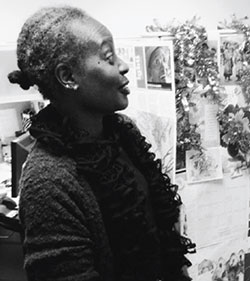
People
These Are Our Change Agents
EDI Change Agent
Shileta Gorham is a change agent for the disability community here at the National Institutes of Health (NIH), bringing attention to the accessibility challenges for individuals with physical disabilities. Because of Shileta, the sidewalk between Building 2 and Building 31 on NIH's main campus was removed and replaced at a lower grade that will allow individuals with physical disabilities to safely access Building 31 without needing to change their route.
What led you to your career? Did you choose it? Did it choose you?
This career most certainly found me, and I enthusiastically wanted to be a part of it. I wanted individuals like me to have a seat at the table and have a voice.
Change Agent, Tierra Robinson, born in Maryland, is a member of the Piscataway Conoy Native American Tribe and is a Physical Scientist (Environmental) in the Waste and Recovery Branch of Division of Environmental Protection (DEP). Ms. Robinson conducted research as a National Congress of American Indians (NCAI) Native Graduate Public Health Fellow and NIH National Institute of Neurological Disorders and Stroke (NINDS) Post-Baccalaureate Fellow.
Veronica Alvarez, Ph.D.; Senior Investigator and Laboratory Chief, Laboratory on Neurobiology of Compulsive Behaviors (LNCB), National Institute on Alcohol Abuse and Alcoholism (NIAAA)
What inspired you to become a scientist?
Change Agents are cultivators who plant seeds in our lives. Their presence nurtures and molds us every day, giving shape to the environment in which we work. They are fueled by their own passion to contribute and thus incite passion in others. They are the risk takers and the visionaries who see possibilities when others see obstacles.
Dr. Karen Parker, Director of the Sexual & Gender Minority Research Office (SGMRO) at the National Institutes of Health (NIH) is a change agent for the Sexual and Gender Minority (SGM) community due to her vast contributions and support.
How is this change agent addressing issues in the SGM community?
Change Agents are cultivators who plant seeds in our lives. Their presence nurtures and molds us every day, giving shape to the environment in which we work. They are fueled by their own passion to contribute and thus incite passion in others. They are the risk takers and the visionaries who see possibilities when others see obstacles.
Tricia Coffey, Chief of Hospital Information Management in the Clinical Center (CC) at the National Institutes of Health (NIH) is a change agent for the Sexual and Gender Minority (SGM) community by creating a more inclusive and diverse patient experience, both clinical and non-clinical staff training, and supporting and reaching out to other organizations related to gender.
Change Agents are cultivators who plant seeds in our lives. Their presence nurtures and molds us every day, giving shape to the environment in which we work. They are fueled by their own passion to contribute and thus incite passion in others. They are the risk takers and the visionaries who see possibilities when others see obstacles.
Adam Cornish, Operations Coordinator in the National Institute on Aging (NIA) at the National Institutes of Health (NIH) is a change agent for the Sexual and Gender Minority (SGM) community due to his support, fellowship, and commitment.
How is this change agent addressing issues in the SGM community?
Change Agents are cultivators who plant seeds in our lives. Their presence nurtures and molds us every day, giving shape to the environment in which we work. They are fueled by their own passion to contribute and thus incite passion in others. They are the risk takers and the visionaries who see possibilities when others see obstacles.
Change Agents are cultivators who plant seeds in our lives. Their presence nurtures and molds us every day, giving shape to the environment in which we work. They are fueled by their own passion to contribute and thus incite passion in others. They are the risk takers and the visionaries who see possibilities when others see obstacles.
Gabriela (Gaby) Zabala-Alemán, Office of Intramural Training and Education (OITE) Detail at the National Institutes of Health (NIH) is a change agent for the Sexual and Gender Minority (SGM) community for advocating representation among the community and her mentorship.
How is this change agent addressing issues in the SGM community?
Change Agents are cultivators who plant seeds in our lives. Their presence nurtures and molds us every day, giving shape to the environment in which we work. They are fueled by their own passion to contribute and thus incite passion in others. They are the risk takers and the visionaries who see possibilities when others see obstacles.
Dr. Victoria Cargill, Associate Director for Interdisciplinary Research, Office of Research on Women's Health (ORWH) at the National Institutes of Health (NIH) is a change agent for the Sexual and Gender Minority (SGM) community for her leadership, advocacy, and support.
How is this change agent addressing issues in the SGM community?
Change Agents are cultivators who plant seeds in our lives. Their presence nurtures and molds us every day, giving shape to the environment in which we work. They are fueled by their own passion to contribute and thus incite passion in others. They are the risk takers and the visionaries who see possibilities when others see obstacles.
Dr. Vivian Ota Wang, Deputy Director of the Office of Data Sharing in the National Cancer Institute at the National Institutes of Health (NIH) is a change agent for the Sexual and Gender Minority (SGM) community for her research and expertise in race, sex, and gender issues.
How is this change agent addressing issues in the SGM community?
What is your name and professional job title?
Paul Liu, Senior Investigator, and Deputy Scientific Director, National Human Genome Research Institute (NHGRI).
Where were you born?
Beijing, China.
What is your professional background?
I did medical school and residency training in China, received my Ph.D. from the University of Texas in Houston, and did postdoctoral training at the University of Michigan.
I’ve been at the National Institutes of Health since 1993, initially as a Senior Staff Fellow, then tenure-track Investigator, and finally Senior Investigator in 2001.
Ian N. Moore, D.V.M., Ph.D (left)., is a section chief and Rashida M. Moore, D.V.M. (right), is a deputy animal program director, laboratory animal veterinarian where they both work at The National Institute of Allergy and Infectious Diseases (NIAID). The Moore’s share their story, how they are champions for community outreach, what success means to them, and how they can aid in supporting the structure of the Science, Technology, Engineering and Math (STEM) education pipeline for African-American students as change agents.
Where were you born?
Ian: Pensacola, Florida.
Rashida: Detroit, Michigan.
How important is community outreach to you?
Wanda Whitney is a Librarian at the National Library of Medicine (NLM). Whitney provided some insight on the importance of community outreach and enhancing educational and professional development for African-American students.
How long have you been at the NIH?
13 years (10 years as a federal employee).
What is your professional background?
I was a Spanish professor in my first career. I have a Ph.D. in Spanish with a concentration in Latin American literature. After teaching for a few years, I returned to graduate school to get a Masters in Library Science (MLS).
Robert "Rob" Clay Rivers is a program director at the National Institute of Diabetes and Digestive and Kidney Diseases (NIDDK). Rivers’ commitment to increasing the representation of African-Americans in Science, Technology, Engineering and Math (STEM), accomplishments and efforts in outreach make him a change agent for African-Americans.
Where were you born?
Fort Bragg, North Carolina.
How important is community outreach to you?
Jennifer Evans (Haliwa-Saponi Tribe) at National Institute of Environmental Health Sciences (NIEHS) and Ashley Wells (Occaneechi-Saponi Tribe) at the office of Equity, Diversity, and Inclusion (EDI).
Ashley Wells: What’s your Tribal Name?
Jennifer Evans: Haliwa-Saponi
Ashley Wells: Where were you born?
Jennifer Evans: Greenville, NC
Ashley Wells: How important is community outreach to you?
"Trans people are like everyone else. They are beautiful, intelligent and accomplished, and they can do that much more if they are provided with the same love and support that every human being deserves."
– JoAnne Keatley
We chose to spotlight phenomenal women in the month of March in in honor of Women’s History Month. It’s the perfect time to share the inspiring story of one heroic woman who is positively impacting the lives of so many transgender people nationally and around the world by promoting equal access in health care.
Sherri Cook has been with the National Institutes of Health (NIH) since 2006 and is a member of the Equity, Diversity, and Inclusion’s (EDI) Portfolio for Blacks Committee. Her understanding of the importance of equity, diversity and inclusion here at the NIH is what motivated her to volunteer. As a committee member, she assists the committee chair with coordinating programs, activities, and initiatives, as well as, examining barriers to the employment, promotion and advancement of Blacks at the NIH.
Cook’s formal role at the NIH is Program Support Assistant in the Epidemiology and Genomics Research Program (EGRP) where she provides programmatic and administrative support to EGRP's Methods and Technologies Branch.
As Malcolm Gladwell observes in his book, The Tipping Point, "The success of any kind of social epidemic is heavily dependent on the involvement of people with a particular and rare set of social gifts." Alfreda Layne is such a person, and as such, serves as a catalyst for change at NIH.





